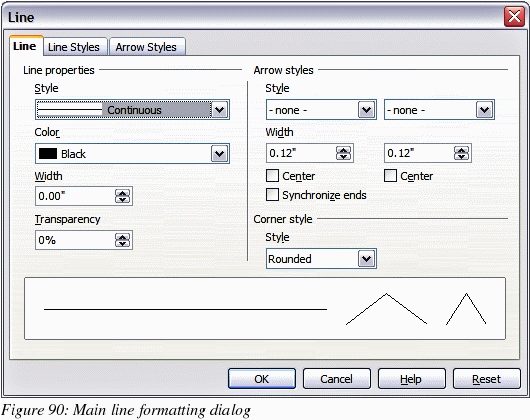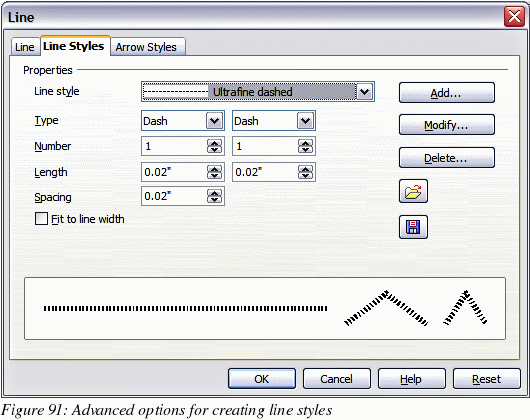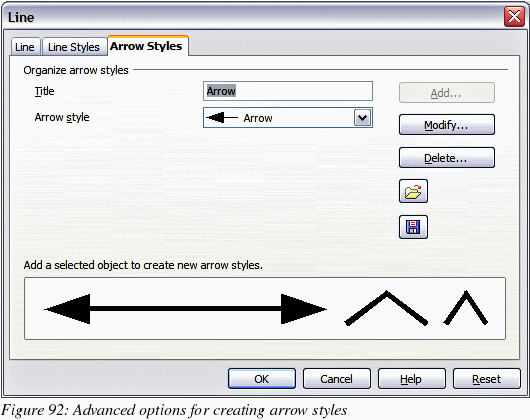Formatting lines
The
dialog to format the line properties is shown in Figure 90. It
contains three pages.
The
Line
page is further subdivided into four parts handling different
aspects of the line.
The
Line
Properties section (left side) is the most
important. It includes the following parameters:
Line
style: a variety of line styles is available in the
drop-down list, but more can be defined if needed.
Color:
pick among the already defined colors. If a color not in the list
is needed, refer to “Creating colors” on page 129 to create a
new one.
Width:
specifies the thickness of the line.
Transparency:
sets the transparency value of the line, a useful property when you
do not want to hide completely what is under the line.

The
Arrow
styles section of this page is only applicable to
line segments; it has no effect on the line that forms the border of
a shape or of a polygon. Use this section to set the styles of the
two ends of the segment. You can configure independently the two
ends, selecting for each of them the arrow shape (Style
drop-down menu), the Width,
and the termination style (Center
checkbox). Selecting the Center
checkbox moves the center of the arrowheads to the end point of the
line. If the two ends should be identical, select the Synchronize
ends checkbox. To create new arrowheads, use the Arrow
styles page, as described in the following
section.
Use
the Corner
style section of this page to choose how the
connection between two segments should look. There are four
available options in the drop down menu.
The
bottom part of the page shows a preview of the applied style and a
preview of two corners so that the corner style choice can be
quickly evaluated. To appreciate the difference between corner
styles, choose a thick line style and observe how the preview
changes.
Creating
line styles
Use
the Line
Styles page of the Line dialog (shown in Figure 91)
to create new line styles and load previously saved line styles.
Normally it is not a good practice to modify the predefined styles;
instead, create new ones when necessary.

To
create a new line style:
Choose
Format > Line
from the menu bar.
Select
from the Line
style drop down menu a style similar to the
desired one.
Click
Add. On the
pop-up dialog, type a name for the new line style and click OK.
Now
define the new style. Start by selecting the line type for the new
style. To alternate two line types (for example, dashes and dots)
within a single line, select different types in the two Type
boxes.
Specify
the number and length (not available for dot style) of each of the
types of line selected, set the spacing between the various
elements, and decide if the style should fit to the line width
(length).
The
new line style is available only in the current presentation. If you
want to reuse the line style in other presentations, click the Save
Line Styles icon and type a memorable name. This saves
all of the line styles in this presentation. (Saved styles have a
file extension of .sod.)
To
make previously saved line styles available in the current
presentation, click the Load
Line Styles icon, select the saved list of styles, and
click Open.
Use
the Modify button
to change the name of the style. Recommended only for custom line
styles, not the built-in ones.
Creating
arrow styles
Use
the third page of the Line dialog to create new arrow styles, modify
existing arrow styles, or load previously saved arrow styles.
The
first step is to draw a curve with the shape you want for the
arrowhead.
|
Note
|
The
arrowhead must be a curve.
A curve is something you could draw without lifting a pencil.
For example, is a curve but is not a curve.
|
Select
the curve. With the resizing handles showing, select Format
> Line from the menu bar, or right-click and choose
Line from the
pop-up menu.
Go
to the Arrow
styles page (Figure 92), click the Add
button, type a name for the new arrow style, and click OK.

Now
you can access the new style from the Arrow style list. When you
select the name of the new style, it is shown at the bottom of the
dialog.
